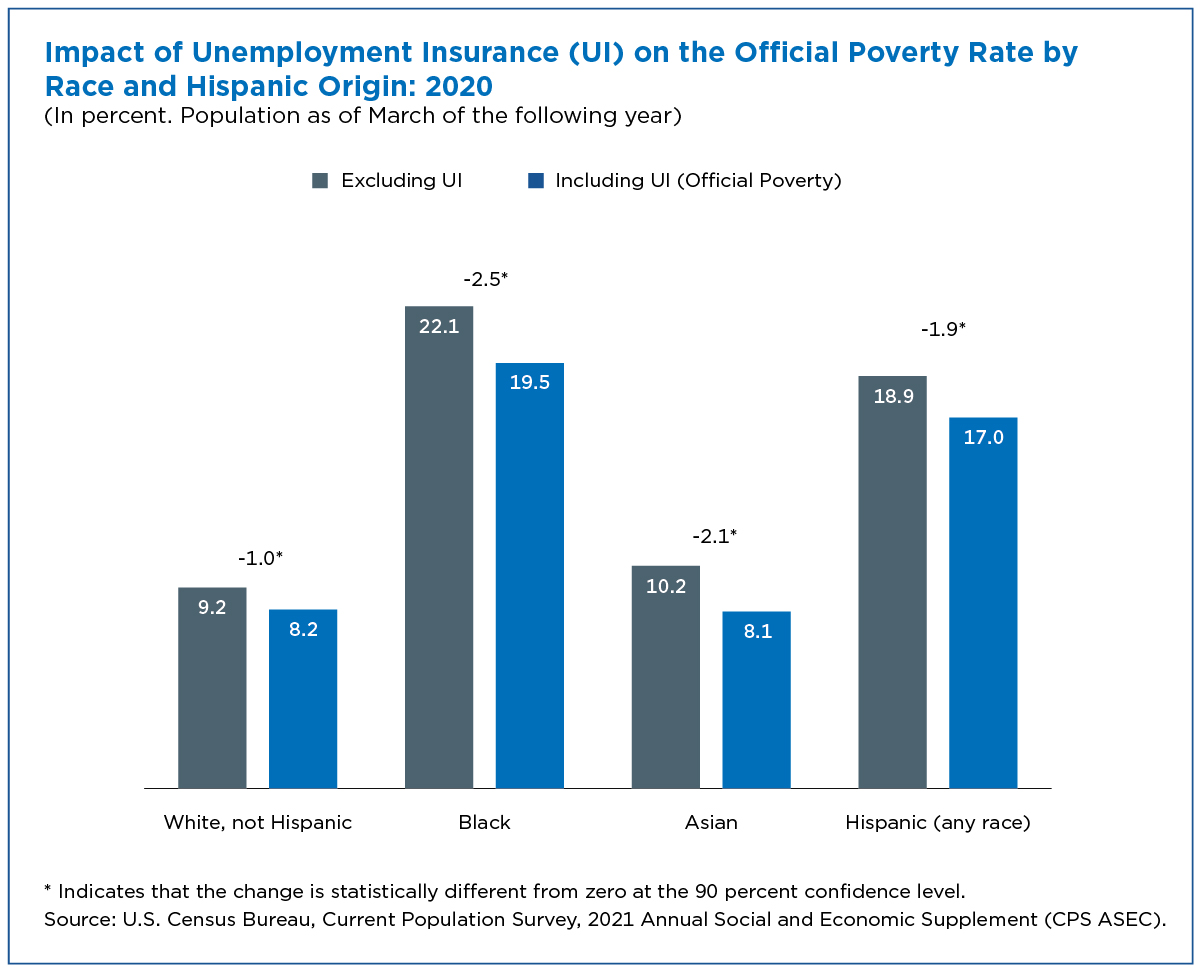Expanded Unemployment Insurance Benefits During Pandemic Lowered Poverty Rates Across All Racial Groups
In the early months of the COVID-19 pandemic, shutdowns across the country resulted in rapid job loss. In response to soaring unemployment, Congress passed the Coronavirus Aid, Relief, and Economic Security (CARES) Act in late March 2020. The CARES Act significantly expanded unemployment insurance by $600 a week, broadened eligibility, and extended benefits for an additional 13 weeks.
How did these moves affect the official poverty rate?
Unemployment insurance (UI) benefits lowered the overall poverty rate by 1.4 percentage points to 11.4% in 2020 and decreased poverty across all racial groups and all age groups, according to U.S. Census Bureau data released today (differences due to rounding).
Without unemployment insurance, 4.7 million more people would have been in poverty and the overall poverty rate would have been 12.9% in 2020.
Without unemployment insurance, 4.7 million more people would have been in poverty and the overall poverty rate would have been 12.9% in 2020. Less than full-time, year-round workers were among the most impacted by expanded unemployment insurance benefits.
UI lowered the poverty rate for less than full-time, year-round workers by 4.1 percentage points (2.2 million) in 2020.
The effects of UI on poverty rates were particularly stark for some demographic groups.
Race and Hispanic Origin
Unemployment insurance had a large impact on poverty among the Black population, lowering the number of Black people living in poverty by 2.5% (1.1 million).
Impact of UI on other groups:
- For White, non-Hispanic individuals, the number in poverty decreased by 1.0% (1.9 million).
- For Hispanic individuals, the number in poverty dropped by 1.9% (1.2 million).
- For Asian individuals, 2.1% (425,000) were not in poverty due to UI.
The decline in poverty rates between Asian and Hispanic individuals and Asian and Black individuals were not statistically different.
Age
Unemployment insurance lowered the number of individuals in the United States living in poverty for all age groups in 2020.
UI had the greatest impact on children (under age 18) and the least impact on people 65 and older.
The number of children living in poverty fell by 2.0% (1.4 million) after including the value of UI while the number of people ages 18 to 64 living in poverty fell by 1.6% (3.1 million).
Among people ages 65 and older, UI pulled only 0.3% (160,000) out of poverty.
Educational Attainment
Unemployment insurance lowered the number of people living in poverty across all educational attainment groups.
UI had the smallest effect on the poverty rate of those with a bachelor’s degree, keeping only 0.7% (636,000) of these individuals out of poverty.
The effects were higher for all other attainment groups:
- For those with some college, 1.5% (855,000 people) were not in poverty due to UI.
- For those with a high school diploma but who did not attend college, the number in poverty dropped 1.5% (948,000).
- For people without a high school diploma, the decline was 1.5% (307,000).
The percentage point decline in poverty rates between those without a high school diploma was not significantly different from the decline in poverty rates for those with a high school diploma who did not attend college or attended some college.
Neither the decline in poverty rate nor the change in the number of people in poverty were significantly different between those with a high school diploma who did not attend college and those with some college.
Frances Chen and Em Shrider are survey statisticians in the Census Bureau’s Poverty Statistics Branch.
Introduction to Income and Poverty in the United States
Subscribe
Our email newsletter is sent out on the day we publish a story. Get an alert directly in your inbox to read, share and blog about our newest stories.
Contact our Public Information Office for media inquiries or interviews.
-
America Counts StoryWho Was Lifted Out of Poverty by Stimulus Payments?September 14, 2021Supplemental Poverty Measure shows that the first two rounds of stimulus payments during the pandemic helped pull 11.7 million people out of poverty in 2020.
-
America Counts StoryPandemic Earnings Decline but Increase for Full-Time, Yearly WorkersSeptember 14, 2021How could earnings for full-time, year-round workers go up while earnings fell for all workers? There were fewer low-wage full-time, year-round workers.
-
America Counts StoryUninsured Rates for Children in Poverty Increased 2018–2020September 14, 2021Changes in children’s health coverage varied by poverty status from 2018 to 2020.
-
America Counts StoryPrivate Health Coverage of Adults Drops From Early 2019 to Early 2021September 14, 2021In early 2020, a decline in the number of working-age adults with private health insurance was offset by an increase in public health insurance programs.
-
America Counts StoryUnderstanding Equity Through Census Bureau DataSeptember 14, 2021U.S. Census Bureau surveys and programs provide insight into social, economic and housing equity gaps in the United States.
-
Business and EconomyWhat Is the Nonemployer Marine Economy?April 09, 2025Thirty states had nonemployer businesses in marine economy sectors, including six states in the Midwest with receipts totaling nearly $11 billion in 2022.
-
Business and EconomyEconomic Census Geographic Area Statistics Data Now AvailableApril 07, 2025A new data visualization based on the 2022 Economic Census shows the changing business landscape of 19 economic sectors across the United States.
-
Income and PovertyWhat Sources of Income Do People Rely On?April 02, 2025A new interactive data tool shows income sources for hundreds of demographic and economic characteristic combinations.
-
Business and EconomyBig Improvements to the Annual Integrated Economic Survey (AIES)March 26, 2025The Census Bureau is making several changes and enhancements to capture 2024 economic data based on feedback from last year’s survey.










